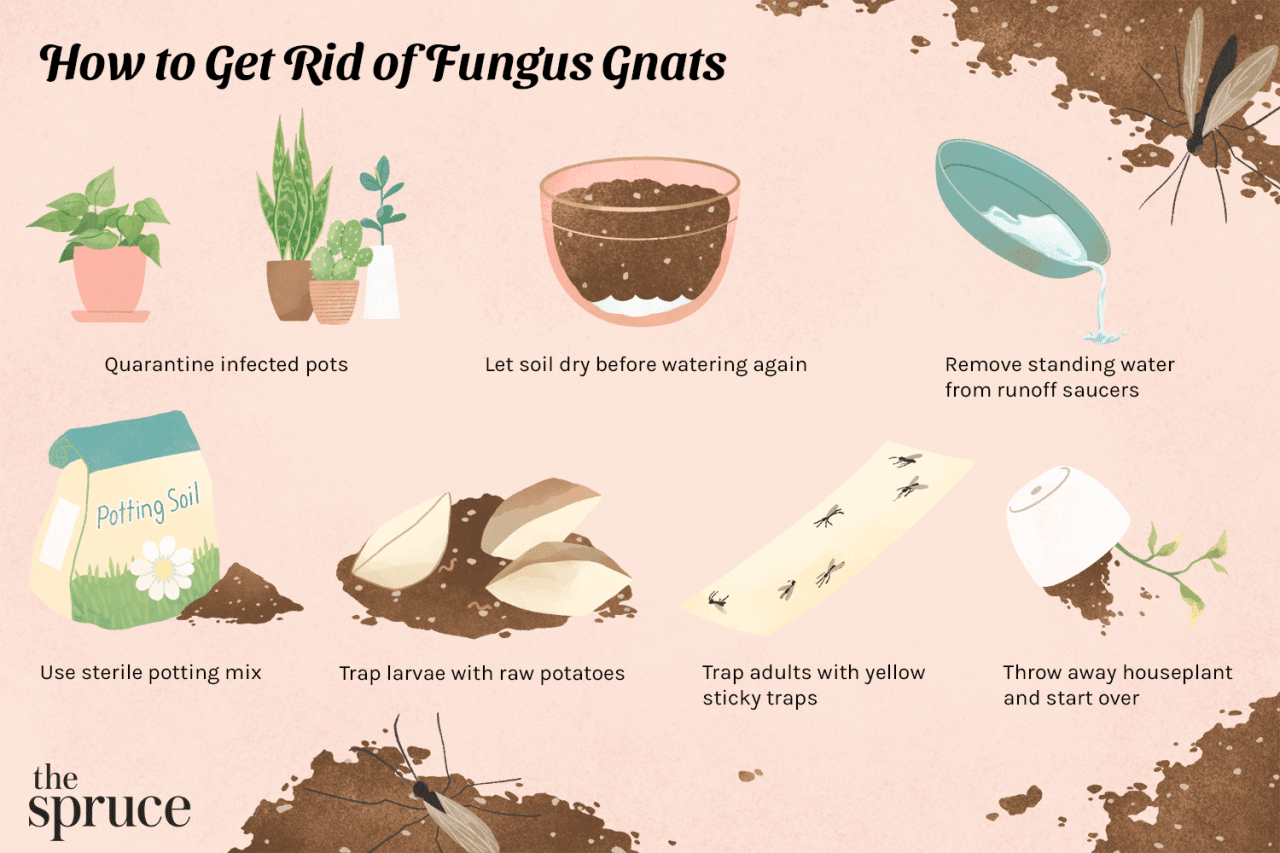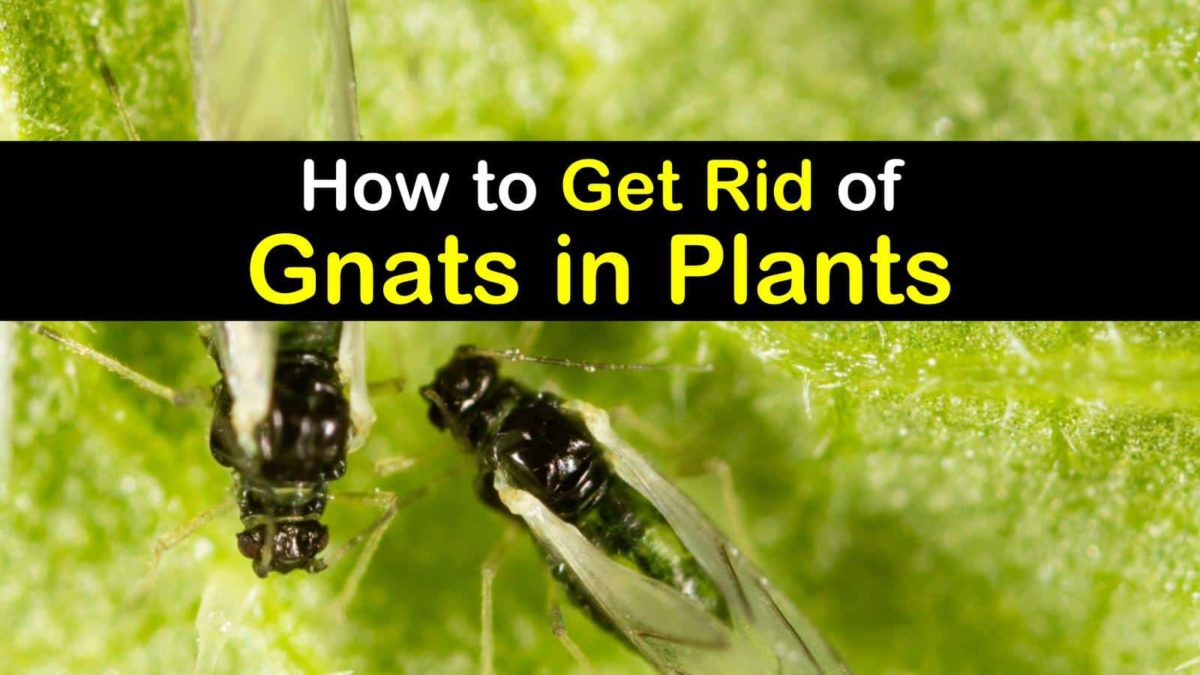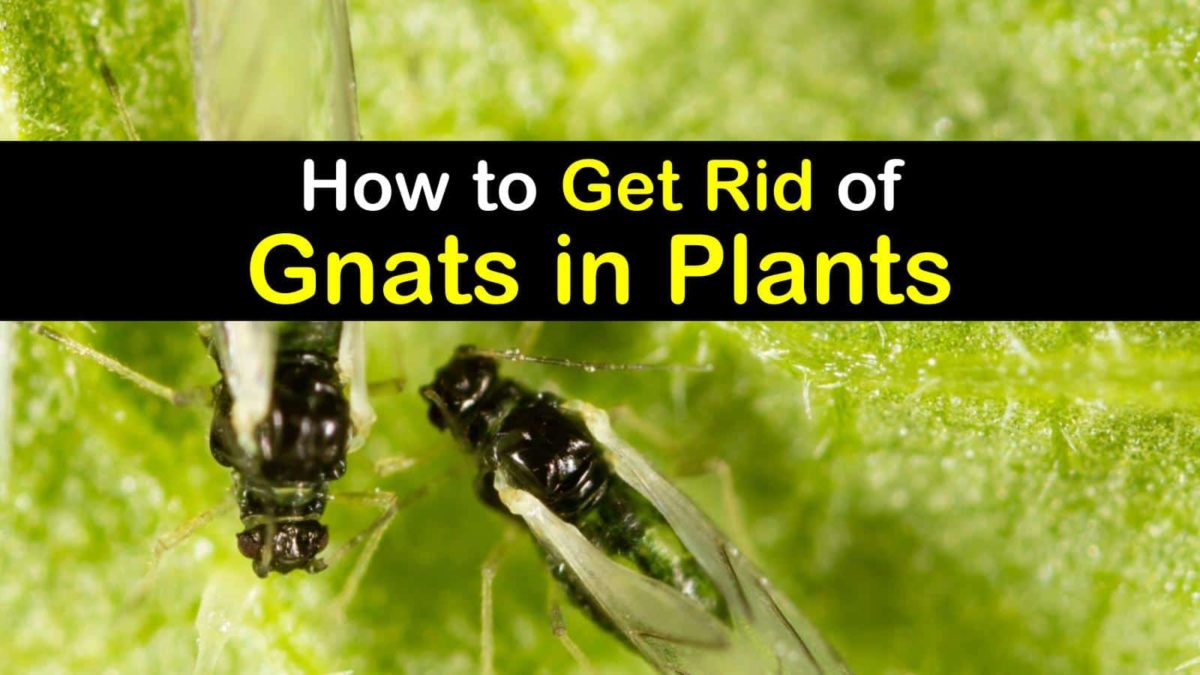How to Stop Gnats from Laying Eggs in Plant Soil is a crucial topic for any gardener or plant enthusiast. These tiny pests, often overlooked, can quickly infest your prized plants, causing damage and potentially spreading disease. Understanding the gnat life cycle, identifying signs of infestation, and implementing preventative measures are essential to maintaining healthy plants and a pest-free environment.
Gnats, particularly fungus gnats, are attracted to moist soil rich in organic matter, which provides ideal conditions for their eggs to hatch. These pesky insects can quickly multiply, leading to a full-blown infestation. Recognizing the signs of a gnat problem early on is key to effectively controlling them.
This guide provides practical strategies and tips for preventing and eliminating gnat infestations, ensuring your plants thrive.
Understanding Gnats and Their Life Cycle: How To Stop Gnats From Laying Eggs In Plant Soil

Gnats are tiny, flying insects that are commonly found in moist environments, including houseplants. While they are generally harmless, they can be a nuisance, especially when they lay eggs in your plant soil, leading to an infestation. Understanding their life cycle is crucial for effectively preventing and controlling gnat problems.
Gnats are a common pest in potted plants, attracted to the moist soil where they lay their eggs. To deter these pesky insects, consider using a layer of diatomaceous earth on the soil surface, which acts as a natural insecticide.
If you’re looking to add some visual appeal to your patio while keeping gnats at bay, consider incorporating hanging plants like petunias or geraniums, as they offer a beautiful and practical solution. Hanging Plants to Brighten Up Your Patio can also provide a natural barrier, making it more difficult for gnats to reach the soil.
Remember to regularly check your plants for signs of infestation and address any issues promptly to keep your patio vibrant and gnat-free.
The Life Cycle of Gnats
The life cycle of gnats involves four distinct stages: egg, larva, pupa, and adult. The egg-laying stage is the primary focus for preventing gnat infestations in plant soil.
- Eggs:Gnat eggs are tiny, white, and oval-shaped. They are typically laid in clusters in moist soil, often near the surface. They are often laid in moist areas like plant soil, compost, or decaying organic matter.
- Larvae:Gnat larvae are small, worm-like creatures that feed on decaying organic matter in the soil. They are often called “fungus gnats” because they feed on fungi and other microorganisms found in the soil.
- Pupae:After the larval stage, gnats enter the pupal stage, where they transform into their adult form. Pupae are usually found in the soil and are often dark brown or black.
- Adults:Adult gnats are the flying insects that we typically see around our plants. They are usually small, with a wingspan of about 1/8 inch. Adult gnats are attracted to moisture and will often lay their eggs in moist soil.
Ideal Conditions for Gnat Eggs to Hatch
Gnat eggs require specific conditions to hatch and develop into larvae.
Keeping gnats at bay is crucial for maintaining healthy houseplants, especially when you’re striving for a lush indoor environment. A simple solution is to use a layer of gravel or pebbles on top of your soil, which deters gnats from laying eggs.
If you’re looking to add some vertical greenery, consider incorporating hanging plants, as they can create a stunning visual appeal and contribute to a vibrant green oasis. How to Create a Green Oasis with Hanging Plants Remember, a healthy soil environment is essential for both your plants and your overall indoor air quality.
To ensure your plants thrive, it’s important to address any pest issues, such as gnats, and create a conducive environment for growth.
- Moisture:Gnat eggs need a moist environment to hatch. This is why they are often found in plant soil, which is typically kept moist for plant growth.
- Temperature:The optimal temperature for gnat egg hatching is between 70°F and 80°F (21°C and 27°C). Warm temperatures promote faster development.
- Food Source:Gnat larvae need a food source to survive. This is usually found in the form of decaying organic matter, fungi, or microorganisms in the soil.
Types of Gnats Commonly Found in Plant Soil
There are several types of gnats that are commonly found in plant soil, but the most prevalent are fungus gnats.
- Fungus Gnats:These are small, dark-colored gnats that are often found in clusters around houseplants. They are attracted to moist soil and will lay their eggs in the soil, where the larvae feed on decaying organic matter and fungi.
- Shore Flies:These are slightly larger than fungus gnats and have a more prominent body. They are often attracted to damp areas, including plant soil. Their larvae feed on decaying organic matter and algae.
- Drain Flies:These are small, gray gnats that are often found in damp areas, such as bathrooms and kitchens. They are attracted to drains and will often lay their eggs in the slime that accumulates in drains.
Identifying Gnat Infestation
Identifying a gnat infestation in your plants requires a keen eye for subtle signs. The tiny size of these pests can make them difficult to spot, but there are several indicators to look out for.
Visual Cues of Gnat Eggs in Plant Soil
Gnat eggs are typically white, translucent, and oval-shaped. They are usually found in clusters, often near the surface of the soil. These eggs are so small, they are almost invisible to the naked eye. To identify them, you need to carefully examine the soil surface with a magnifying glass.
Identifying Gnat Larvae in the Soil
Gnat larvae are small, white, and worm-like. They are often found in the top layer of the soil, near the roots of plants. If you see these larvae, it’s a sure sign of a gnat infestation. To spot them, gently lift the top layer of soil and look for small, white worms moving around.
Adult Gnat Behavior Near Plants, How to Stop Gnats from Laying Eggs in Plant Soil
Adult gnats are small, flying insects that are attracted to moisture and decaying organic matter. They often swarm around plants, especially those that are overwatered. If you see adult gnats hovering around your plants, it’s a good indication that you have a gnat infestation.
Control Methods
Controlling gnat infestations in plant soil requires a multifaceted approach that combines preventive measures with targeted treatments. This section explores effective control methods, encompassing both natural and chemical options, to help you eliminate existing gnat infestations and prevent future occurrences.
Natural Control Methods
Natural control methods are environmentally friendly and often safe for pets and children. They focus on disrupting the gnat’s life cycle and creating an unfavorable environment for their survival.
- Yellow Sticky Traps:These traps attract and capture adult gnats, reducing their ability to reproduce. The bright yellow color is highly visible to gnats, and the sticky surface traps them effectively. Simply place the traps near your plants, and replace them as they become full.
- Neem Oil:Neem oil is a natural insecticide derived from the neem tree. It disrupts the gnats’ growth and development, making it an effective deterrent. Dilute neem oil with water according to the product instructions and apply it to the soil surface.
Repeat the application every few weeks, or as needed.
- Diatomaceous Earth:This fine powder is made from fossilized diatoms. When gnats come into contact with diatomaceous earth, it scrapes their exoskeletons, causing dehydration and death. Sprinkle a thin layer of diatomaceous earth around the base of your plants, avoiding direct contact with the foliage.
Reapply as needed.
- Apple Cider Vinegar Trap:This simple trap utilizes the gnats’ attraction to vinegar. Fill a shallow dish with apple cider vinegar and add a few drops of dish soap. The soap reduces the surface tension of the vinegar, preventing the gnats from escaping. Place the trap near your plants and refresh the solution as needed.
- Mosquito Dunks:These small, donut-shaped tablets contain Bacillus thuringiensis israelensis (Bti), a naturally occurring bacterium that is highly effective against mosquito larvae. They can also be used to control fungus gnat larvae in soil. Place a dunks in a small amount of water near your plants, allowing the Bti to release into the soil and kill the larvae.
Chemical Control Methods
Chemical control methods provide a faster and more aggressive approach to eliminating gnat infestations. However, they may pose risks to pets and children, and some can be harmful to plants. It is essential to use chemical treatments with caution and follow the manufacturer’s instructions carefully.
- Insecticidal Soaps:These soaps contain fatty acids that disrupt the gnats’ cell membranes, leading to death. Apply insecticidal soap to the foliage and soil surface, ensuring thorough coverage. Repeat the application as needed.
- Pyrethrin-Based Insecticides:Pyrethrin is a natural insecticide derived from chrysanthemums. It is effective against a wide range of insects, including gnats. Follow the product instructions carefully when applying pyrethrin-based insecticides to your plants and surrounding areas.
- Neonicotinoid Insecticides:Neonicotinoids are a class of synthetic insecticides that are highly effective against gnats. However, they can be harmful to beneficial insects and wildlife. Use neonicotinoid insecticides only as a last resort and follow the manufacturer’s instructions carefully.
Maintaining a Gnat-Free Environment

Proactive measures are crucial in preventing gnat infestations. Creating a healthy soil environment that discourages gnat reproduction is essential for long-term gnat control. By understanding gnat behavior and implementing these strategies, you can minimize their presence in your plants.
Soil Management Practices
Maintaining healthy soil conditions is vital for deterring gnat infestations. Gnats thrive in moist, nutrient-rich environments, so it’s essential to strike a balance between providing adequate moisture and preventing excessive dampness.
- Watering Techniques:Gnats are attracted to damp soil. Avoid overwatering, which creates a breeding ground for them. Water your plants thoroughly but allow the top inch of soil to dry out between waterings. Consider using a moisture meter to gauge soil moisture levels.
- Fertilizing Practices:Excessive fertilization can contribute to gnat infestations. Overfeeding creates an abundance of organic matter, which gnats find attractive. Opt for slow-release fertilizers and avoid over-fertilizing.
- Soil Aeration:Well-aerated soil promotes drainage and discourages gnat breeding. Regularly loosen the top layer of soil to improve air circulation and reduce moisture retention.
Plant Hygiene
Keeping your plants clean and free of debris can significantly reduce gnat attraction.
- Removing Debris:Regularly remove dead leaves, stems, and other plant debris from the soil surface. These materials can decompose and create a favorable breeding ground for gnats.
- Cleaning Plant Surfaces:Wipe down plant leaves with a damp cloth to remove dust and debris. This helps prevent the buildup of organic matter that can attract gnats.
Final Thoughts

By understanding the life cycle of gnats, recognizing signs of infestation, and implementing effective preventative and control measures, you can successfully protect your plants from these pesky insects. Remember, a proactive approach is key to maintaining a gnat-free environment and ensuring the health and vitality of your indoor and outdoor gardens.
FAQs
What are the most common types of gnats that infest plant soil?
The most common types of gnats found in plant soil are fungus gnats and shore flies. Fungus gnats are attracted to moist soil and decaying organic matter, while shore flies prefer damp areas and decaying plant material.
Can I use a pesticide to get rid of gnats in my plants?
While pesticides can be effective in killing gnats, they can also harm beneficial insects and disrupt the delicate balance of your soil ecosystem. Consider using natural control methods first and resorting to pesticides only if necessary.
How often should I water my plants to prevent gnat infestations?
The frequency of watering depends on the plant species and environmental conditions. It’s crucial to allow the top inch of soil to dry out between waterings to prevent overly moist conditions that attract gnats.
